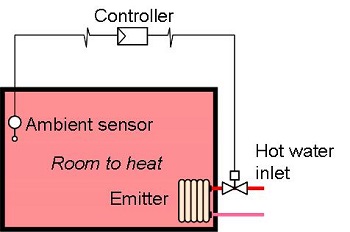In our branch, the easiest control method is control depending on interior temperature.
The principle is, in theory, the most certain because the regulator controls the output value directly.
The regulator « surveys » the ambient temperature of a room by means of a sensor:
- In heating mode, if the ambient temperature drops, the controller gives the order to increase heating power and vice versa.
- In cooling mode, if the ambient temperature increases, the controller gives the order to increase cooling power and vice versa.

However, in hot water central heating, we also use the principle of control depending
on outside temperature.
In this case, the controller does not directly “survey” the output value
to be adjusted but acts depending on the main variable value.
Regulating is less obvious. A variation in outside temperature leads to a
correction of the emitter output but the controller cannot read the variation
of inside temperature obtained. It can therefore not readjust the power if the
transmitted correction is badly set.
This control principle is not possible with air conditioning because the
outside temperature is not the only main variable value. Notably, internal heat
generation (lighting, occupants, and machines) can also cause large variations.
In the heating field, we use outside temperature-based control because it allows:
- A better anticipation of required power variations when the heating system is very inert (under-floor heating).
- A better control of hot water heating temperature, useful for condensation boilers.
- Regulating a group of rooms for which a single inside temperature control would not be suitable (collective heating).
To summarise:
- If we regulate a heating system for a group of rooms (apartment blocks, offices), without knowing in which room to correctly control the temperature, the regulating will be most often carried out depending on the outside temperature.
- If we regulate a system for a single room (an office, a shop, etc.) or for just a few communicating rooms (a flat, a house, etc.) the regulating can be done depending on inside temperature.
But, with individual heating :
- When the heating system is very inert (under-floor heating) control by outside temperature is a good solution because it allows a more rapid increase or decrease in floor heating power.
- With a condensation boiler, control by outside temperature is a good solution because it allows a maximum reduction in heating water temperature.
- With a control depending on outside temperature, it is possible to have a complimentary inside temperature control. This control, called a compensator, allows a better adjustment of orders transmitted by the controller.
With air-conditioning, the exterior temperature is not sufficiently representative of cooling requirements. We control the air-conditioning of each zone according to its ambient temperature.
